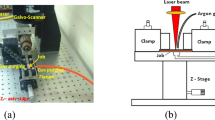Abstract
In this paper continuous laser welding of two dissimilar materials, aluminum and copper, was investigated. The aluminum and the copper utilized were Al3003-H14 and Cu110-H00, respectively. Two different sets of samples were laser welded; one in which a filler material, tin foil alloy (S-bond 220), was sandwiched between the aluminum and the copper and another set in which the aluminum and copper were directly welded without any filler. The foil alloy was utilized to enhance the compatibility of the two metals; aluminum and copper, reducing the brittleness of the intermetallic compound that may form and, subsequently, enhance the mechanical properties. The welding was carried out using an IPG 500 SM fiber laser. The length of the laser joint produced was 20 mm and the width was about 200 µm. The strength of the joint was evaluated by conducting the lap shear stress test. Samples in which filler foil was used exhibited a better performance in the lap shear stress test (an average of 780 N) than the samples without tin foil (an average of 650 N). The improvement in the lap shear test could be attributed to the positive effects of the filler on enhancing the compatibility of the intermetallic compound formed via diffusion. The fracture surface of both types of joints (with and without filler) was characterized using scanning electron microscope equipped with energy-dispersive X-ray (EDAX). To understand the failure initiation and propagation of the samples under tension, a finite element (FE) model was developed for the samples created with no filler material. The failure mechanism predicted from the FE model matches reasonably well with the experimental observations from EDAX analysis.














Similar content being viewed by others
References
Davis JR (ed) (1998) Metals handbook, 2nd edn. ASM International, Materials Park, OH. ISBN 0-87170-654-7
Chadwick R (1938) The influence of surface alloying on the strength of soft soldered joints. J Inst Met 62:277
Chatter S, Abinandanon TA, Chattopadhyay K (2006) Microstructure development during dissimilar welding: case of laser welding of Ti with Ni involving intermetallic phase formation. J Mater Sci 41:643
Ege ES, Inal OT (2000) Stability of Interfaces in explosively-welded aluminum-titanium laminates. J Mater Sci 19:1533–1535
Esser G, Mys I, Schmdit MH (2004) Laser micro welding of copper and aluminum using filler materials. Proc SPIE 5662:337–342
Hansen M, Elliott R, Shunk F (1958) Constitution of binary alloys. McGraw-Hill, NY, USA
Huntington CA, Eager TW (1982) Laser welding of aluminum and aluminum alloys. In: 63rd AWS annual convention in Kansas-Missouri 25–30
Kreimeyer M, Wagner F, Vollertsen F (2005) Laser processing of aluminum-titanum-tailored blanks. Opt Laser Eng 43:1021–1035
Lee YG, Duh JG (1998) Characterizing the formation and growth of intermetallic compound in the solder joint. J Mater Sci 33:5569
Mai TA, Spowage AC (2004) Characterization of dissimilar joint in laser welding of steel-kovar, copper-steel and copper-aluminum. Mater Sci Eng A 374:224–233
Mys I, Schmdit M (2006) Laser micro welding of copper and aluminum. Proc SPIE 6107:28
Olowinsky AM, Kramer T, Durand F (2002) Laser microwelding in the watch industry. SPIE Proc 4637:571–580
Pang M, Yu G, Wang H, Zheng C (2008) Microstructure study of laser cast nickel-based superalloy K418. J Mater Proc Technol 207:271–275
Pastor M, Zhao H, Martukanitz R, DebRoy T (1999) Porosity, underfill, magnesium loss during continuous wave Nd:YAG laser welding of thin plates of aluminum alloy 5182 and 5754. Weld J 78(6):207–216
Phanikumar G, Manjini S, Dutta P, Mazumdar J, Chattopadhyay K (2005) Characterization of a continuous CO2 Lser-welded Fe-Cu dissimilar couple. Metall Mater Transac A: Phys Metall Mater Sci 36(8):2137–2147
Sepold G, Scubert E, Zerner E (1999) Laser beam joining of dissimilar materials. IIW IV-739-99, Lisbon
Sun Z, Ion JC (1995) Laser welding of dissimilar welding metal combinations. J Mater Sci 30:4205–4214
Sun Z, Moisio T (1994) Melting ratio in laser welding of dissimilar metals. J Mater Sci Lett 13:980–982
Swanger H, Maupin AR (1942) Structural changes in the bonding layer of soft-soldered joint in copper pipe line on long-continued heating. J Res Nat Bureau Stand 28:479
Author information
Authors and Affiliations
Corresponding author
Rights and permissions
About this article
Cite this article
Hailat, M.M., Mian, A., Chaudhury, Z.A. et al. Laser micro-welding of aluminum and copper with and without tin foil alloy. Microsyst Technol 18, 103–112 (2012). https://doi.org/10.1007/s00542-011-1378-8
Received:
Accepted:
Published:
Issue Date:
DOI: https://doi.org/10.1007/s00542-011-1378-8




